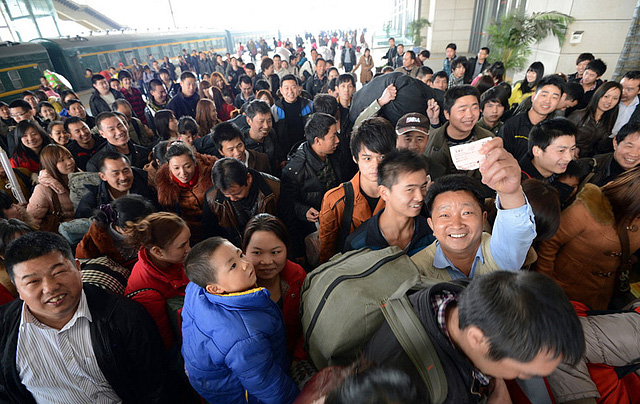he Spring Festival, or Chinese New Year, is the most important of the traditional Chinese holidays.
For Chinese people, it is a time for family reunion, just like the
Christmas in the West. Tens of millions of people travel to their family
homes, after living away from hometown for a full year. In 2013, the
festival falls on Feburary 10, which means the holiday travel period
will probably span from Jan. 26 to March 6. The 40-day period is called "Chunyun" (春运), literally "transportation during Spring Festival", known
as the world’s largest annual migration.
A record 3.41 billion trips are expected to be made during the 40-day travel rush. It’s as if half of the entire population of the world have decided to hit the road. Obviously, the travel rush is set to strain the capacity of China’s transport system, especially the railway. This year, China’s railways are expecting 225 million passenger trips, ten million more than last year.
During this year’s travel season, high speed rail has proven to be a very popular option. The Beijing-Guangzhou high-speed railway, the world’s longest, opened on Dec. 26, cutting the travel time to about 8 hours from the current 20-odd hours by traditional lines. The new line gives passengers more choices for transportation, and relieves the pressure on the Spring Festival travel rush.
The Beijing-Guangzhou high-speed railway is one of four north-south lines expected to serve as a backbone for the country’s high-speed railway network, which also features four east-west lines. The four north-east railways will connect Beijing with metropolises like Shanghai and Guangzhou as well as the northeastern cities of Shenyang, Harbin and Dalian. They will also link southeastern coastal cities such as Hangzhou, Fuzhou and Shenzhen. The east-west lines will bridge the Beijing-Guangzhou and Beijing-Shanghai high-speed routes and extend the network to western cities like Xi’an, Lanzhou, Chengdu, Chongqing and Kunming.
A record 3.41 billion trips are expected to be made during the 40-day travel rush. It’s as if half of the entire population of the world have decided to hit the road. Obviously, the travel rush is set to strain the capacity of China’s transport system, especially the railway. This year, China’s railways are expecting 225 million passenger trips, ten million more than last year.
During this year’s travel season, high speed rail has proven to be a very popular option. The Beijing-Guangzhou high-speed railway, the world’s longest, opened on Dec. 26, cutting the travel time to about 8 hours from the current 20-odd hours by traditional lines. The new line gives passengers more choices for transportation, and relieves the pressure on the Spring Festival travel rush.
The Beijing-Guangzhou high-speed railway is one of four north-south lines expected to serve as a backbone for the country’s high-speed railway network, which also features four east-west lines. The four north-east railways will connect Beijing with metropolises like Shanghai and Guangzhou as well as the northeastern cities of Shenyang, Harbin and Dalian. They will also link southeastern coastal cities such as Hangzhou, Fuzhou and Shenzhen. The east-west lines will bridge the Beijing-Guangzhou and Beijing-Shanghai high-speed routes and extend the network to western cities like Xi’an, Lanzhou, Chengdu, Chongqing and Kunming.


No comments:
Post a Comment